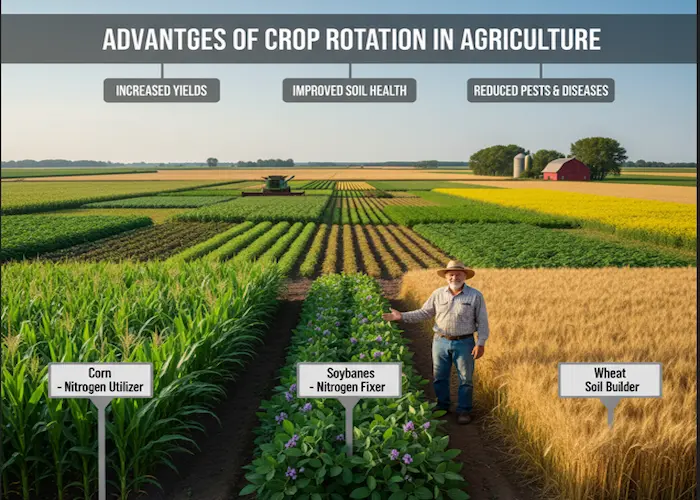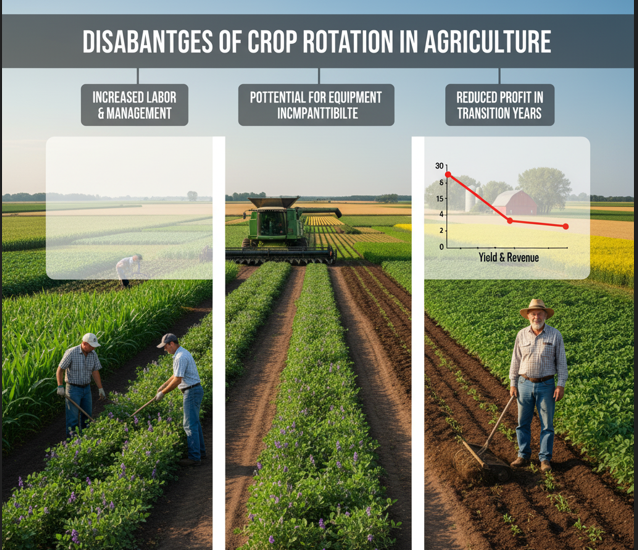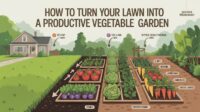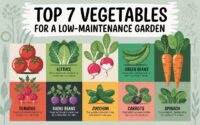Crop Rotation in Agriculture: Key Benefits and Potential Drawbacks
Published: 2025-10-09
Crop rotation involves growing different crops in the same field, one after another, rather than planting the same crop every season. It helps keep the soil healthy and full of nutrients. Farmers have used this method for centuries to get better harvests and protect their land. However, like every farming practice, it has both its advantages and disadvantages.
Knowing the advantages and disadvantages of crop rotation in agriculture helps farmers make smart choices for their fields. In this article, you will learn how crop rotation benefits the soil, saves money, and also what problems it can bring if not done the right way. I’ve seen many people confused about this topic, so let’s break it down.
Quick Summary: Advantages and Disadvantages of Crop Rotation
Crop rotation means growing different crops in the same field season by season. It improves soil fertility, reduces pests, and increases crop yield. However, it also needs proper planning, time, and knowledge. Understanding both the advantages and disadvantages of crop rotation in agriculture helps farmers make smart and sustainable choices for better harvests.
Advantages of crop rotation in agriculture
Crop rotation offers many benefits that help farmers grow healthy crops and protect their soil. It keeps the land fertile, reduces pests, and improves harvests. By changing crops each season, farmers can use natural soil nutrients wisely and depend less on chemical fertilizers. This method also helps in maintaining long-term soil health.

Here are the main benefits of crop rotation in agriculture:
- Improves soil fertility and structure.
- Reduces the risk of pests and diseases.
- Controls weed growth naturally.
- Increases overall crop yield and quality.
- Reduces the need for chemical fertilizers and pesticides.
- Helps maintain soil moisture and prevents erosion.
- Promotes better nutrient balance in the soil.
Let us we will explain all the pros of crop rotation in agriculture one by one.
1. Improves soil fertility and structure
Crop rotation helps the soil stay rich and healthy. Different crops take and give back different nutrients to the soil. This balance keeps the soil fertile and loose for roots to grow well. It also improves air and water movement in the soil. Over time, the soil becomes more productive.
- Keeps the soil full of nutrients.
- Improves root growth and soil texture.
- Helps crops grow stronger and healthier.
2. Reduces the risk of pests and diseases
When the same crop is grown every season, pests and diseases can build up in the soil. Crop rotation breaks this cycle by changing the crop type. Pests lose their usual food source, so their numbers drop naturally. This helps farmers protect their crops without heavy pesticide use.
- Stops pest and disease buildup.
- Keeps plants healthy and safe.
- Reduces the cost of pest control.
3. Controls weed growth naturally
Different crops cover the soil in different ways. Some grow fast and shade the ground, which stops weeds from growing. Others use up the space and nutrients that weeds need. This makes crop rotation a natural way to manage weeds without harmful chemicals.
- Reduces weed competition for nutrients.
- Saves time and money on weed removal.
- Keeps fields cleaner and easier to manage.
4. Increases overall crop yield and quality
Healthy soil leads to better crops. With crop rotation, plants get the right nutrients and face fewer pests and diseases. This means stronger plants and better harvests. Farmers can produce more food and improve crop quality each season.
- Boosts harvest size and profit.
- Produces healthier and tastier crops.
- Keeps the land productive for years.
5. Reduces the need for chemical fertilizers and pesticides
Since crop rotation keeps soil fertile and pests under control, farmers use fewer chemicals. This saves money and protects the environment. Natural soil health also means crops get what they need without extra help. It’s a smart way to farm sustainably.
- Cuts down on chemical use.
- Saves farming costs.
- Protects soil and water from pollution.
6. Helps maintain soil moisture and prevents erosion
Crops with strong roots hold the soil together. This stops wind and water from washing it away. Rotating crops also helps the soil store more moisture. It keeps the land firm and fertile, even in dry conditions.
- Prevents loss of topsoil.
- Improves water retention.
- Keeps the land ready for future crops.
7. Promotes better nutrient balance in the soil
Each crop needs different nutrients from the soil. When crops are rotated, they use and replace nutrients in balance. For example, legumes add nitrogen, which helps the next crop grow better. This natural cycle keeps the soil rich and balanced.
- Maintains natural soil nutrients.
- Reduces the need for extra fertilizers.
- Supports steady and healthy crop growth.
Disadvantages of crop rotation in agriculture
While crop rotation has many benefits, it also comes with some challenges. It needs proper planning and knowledge to choose the right crops for each season. Small farmers may find it hard to manage because it takes more time, effort, and resources. If not done correctly, it can harm the soil instead of helping it.

Here are the main cons of crop rotation in agriculture:
- Requires careful planning and management.
- Takes more time and effort to organize.
- It may not suit small farms with limited land.
- Needs knowledge of different crops and soil types.
- It can cause yield loss if the wrong crops are rotated.
- Hard to manage equipment and labor for changing crops.
- May delay profits due to long-term planning.
We will explain the above-mentioned cons of crop rotation in agriculture one by one.
1. Requires careful planning and management
Crop rotation is not as simple as growing one crop after another. Farmers must plan which crops to plant and when to plant them. Each crop affects the soil differently, so planning mistakes can reduce yields. Good record-keeping and field management are very important.
- Needs proper scheduling and rotation plans.
- Mistakes can harm soil health.
- Demands good management skills.
2. Takes more time and effort to organize
Crop rotation involves more work than planting a single crop every season. Farmers must prepare fields, select seeds, and adjust schedules for each crop. This extra effort can be tiring and time-consuming. It also requires more attention throughout the growing season.
- Increases daily farming tasks.
- Requires more labor and supervision.
- It can slow down other farm activities.
3. May not suit small farms with limited land
Small farmers often have less land to rotate crops properly. With limited space, it’s hard to grow a variety of crops each season. This can reduce the benefits of rotation and make it less effective. Some farmers may prefer growing one profitable crop instead.
- Limited land reduces rotation options.
- Difficult to divide fields for different crops.
- May lower overall profits for small farmers.
4. Needs knowledge of different crops and soil types
Crop rotation works best when farmers understand what each crop needs. They must know how different plants affect soil nutrients and health. Without this knowledge, rotation plans can fail. Learning about crops and soils takes time and experience.
- Requires understanding of plant nutrition.
- Mistakes can lead to poor soil balance.
- Demands training and guidance for success.
5. Can cause yield loss if the wrong crops are rotated
Choosing the wrong crops for rotation can reduce soil fertility instead of improving it. Some crops may compete for the same nutrients, leaving the soil weak. This mistake can cause low yields and poor-quality produce. Careful crop selection is key to success.
- Wrong crops can damage soil nutrients.
- May lead to weak and unhealthy plants.
- Can cause financial loss for farmers.
6. Hard to manage equipment and labor for changing crops
Each crop needs different tools, machines, and care methods. Switching between crops means adjusting equipment and training workers again. This can increase costs and slow down work. It also makes farm operations more complicated.
- Needs different tools for each crop.
- Raises labor and maintenance costs.
- Makes farm management more difficult.
7. May delay profits due to long-term planning
Crop rotation gives results over time, not right away. Farmers may have to wait several seasons to see full benefits. This delay can affect income, especially for those who depend on quick returns. It needs patience and long-term investment.
- Profits come slowly over many seasons.
- Hard for farmers needing a quick income.
- Requires strong financial planning.
Quick Facts about the benefits and drawbacks of crop rotation in agriculture
- Crop rotation isn’t new — farmers have been doing it for thousands of years to keep their soil happy and healthy.
- Some crops, like beans and peas, actually add nutrients to the soil instead of taking them away.
- Rotating crops can cut down on bugs and weeds — nature’s own way of pest control!
- It saves money on fertilizers and chemicals, but only if you plan it the right way.
- Small farms may struggle with crop rotation because they don’t have enough space to switch crops easily.
- The real secret? Patience! Crop rotation works best when farmers think long-term instead of just one season.
Helpful Tips
- Start small: Try crop rotation on a small part of your field first. This helps you learn what works best without taking big risks.
- Know your soil: Test your soil before planning rotations. Good soil knowledge helps you choose the right crops.
- Mix it up: Grow crops with different nutrient needs. For example, plant legumes after grains to refill the soil naturally.
- Keep notes: Write down what you plant each season and how your crops perform. This helps you improve your plan every year.
- Be patient: Crop rotation takes time to show results. Don’t expect big changes after just one season.
- Ask for help: Talk to local farmers or agriculture experts. Their experience can guide you toward better rotation choices.
If you want to make the most out of your farming efforts, it’s important to grow crops that bring good profit along with healthy soil. You can learn more about the best and most money-making crops by visiting our guide on the top 10 most profitable vegetables to grow — perfect for farmers who want both income and sustainability.
FAQs about the pros and cons of crop rotation in agriculture
Here are the main frequently asked questions about the pros and cons of crop rotation in agriculture.
Crop rotation means growing different crops in the same field in a planned order. Farmers use it to keep their soil healthy and full of nutrients. It also helps control pests and diseases naturally. This simple method keeps the land productive year after year.
One negative effect of crop rotation is that it needs a lot of planning. If crops are not chosen carefully, soil nutrients can drop instead of improving. It also takes time and effort to manage different crops. Small farmers may find it hard to follow the rotation properly.
For Class 8 students, the simple answer is: crop rotation takes more time and planning. Farmers must know which crops to grow after each other. If they make mistakes, it can harm the soil and reduce yields. It also costs more to manage at the start.
Too much irrigation can damage the soil and wash away nutrients. It may cause waterlogging, which harms plant roots. In some areas, it also leads to salt build-up in the soil. Using too much water can waste resources and increase costs.
- Improves soil fertility and structure.
- Reduces pests, weeds, and diseases naturally.
- Increases crop yield and quality.
- Cuts down the need for chemical fertilizers.
- Helps maintain soil moisture and prevents erosion.
Conclusion
Crop rotation is a smart and time-tested way to keep soil healthy and crops strong. In this article, we looked at both the good and the bad sides of this farming method. It offers many benefits like better soil, fewer pests, and higher yields. But it also needs planning, knowledge, and patience to work well.
Understanding both advantages and disadvantages helps farmers make wise choices for their land. When done right, crop rotation can bring lasting rewards. Think smart before choosing — the best results come from balance and care.
If you’re interested in other eco-friendly growing methods, don’t miss our guide on the advantages and disadvantages of rooftop gardening — a great read on how rooftop spaces can be turned into green farms.

- Be Respectful
- Stay Relevant
- Stay Positive
- True Feedback
- Encourage Discussion
- Avoid Spamming
- No Fake News
- Don't Copy-Paste
- No Personal Attacks



- Be Respectful
- Stay Relevant
- Stay Positive
- True Feedback
- Encourage Discussion
- Avoid Spamming
- No Fake News
- Don't Copy-Paste
- No Personal Attacks



